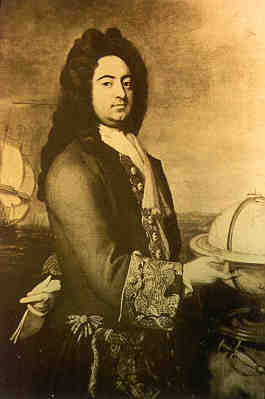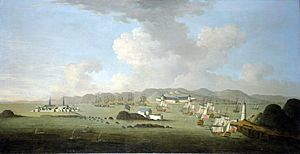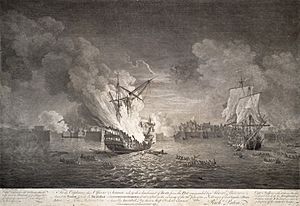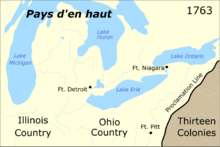Colonial American military history facts for kids
The military history of the Thirteen Colonies covers the time from when the first colonies were settled until the American Revolution began in 1775. It all started on August 29, 1643, when the Plymouth Colony decided to create and maintain a military system.
Contents
Early American Soldiers
Rangers: Frontier Fighters
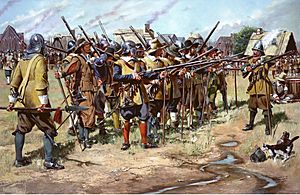
Rangers were special soldiers in North America during the 1600s and 1700s. They fought in wars between the colonists and Native American tribes. Regular soldiers weren't used to fighting on the frontier (the edge of settled lands). So, Ranger companies were formed.
Rangers were full-time soldiers hired by the colonial governments. Their job was to patrol between forts on the frontier. They would scout ahead and give early warnings of attacks. When attacking, they acted as guides, finding villages or other targets for larger groups of soldiers.
Colonel Benjamin Church (born around 1639) is known as the "father of American ranging." He was the leader of the first Ranger force in America in 1676. Governor Josiah Winslow of Plymouth Colony asked Church to form this company for King Philip's War. Church later used his Rangers to raid Acadia during King William's War and Queen Anne's War.
Benjamin Church designed his Rangers to fight like Native Americans. He learned from his Native American allies how to fight in the wilderness. Rangers relied on Native Americans as both allies and teachers. Church created a special unit of white colonists, chosen for their frontier skills, and allied Native Americans. They worked together to attack hostile Native Americans in areas where regular soldiers couldn't fight well.
Two famous Rangers from the 1700s, John Lovewell and John Gorham, had family members who served under Church. Later, Rogers' Rangers was created in 1751 by Major Robert Rogers. He organized nine Ranger companies in the American colonies. These early light infantry units were formed during the French and Indian War. Many see them as the inspiration for today's Army Rangers.
Provincial Troops: Campaign Soldiers
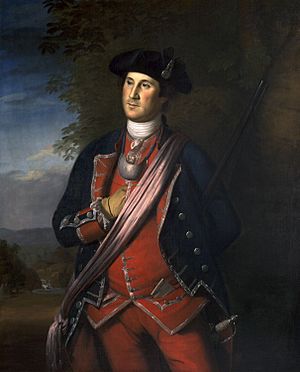
Provincial troops were soldiers raised by colonial governors and lawmakers for long military operations during the French and Indian Wars. They were different from the militia because they were full-time soldiers on extended missions. They were also different from the regular British Army because they were only recruited for one campaign season at a time.
These forces were often recruited by asking the militia for volunteers. Officers were chosen by the colonial governments. Over time, serving in the militia became something for wealthier people. Provincial troops, however, were often recruited from other parts of the community.
The first provincial forces in British North America were formed in the 1670s. Several colonial governments created Ranger companies for a year of paid service to protect their borders. Major operations during King William's War were carried out by provincial troops from Massachusetts Bay. During Queen Anne's War, soldiers from Massachusetts Bay, Connecticut, and New Hampshire made up most of the English forces.
In King George's War, the troops that captured Louisbourg came entirely from Massachusetts, Connecticut, New Hampshire, and Rhode Island. During the French and Indian War, the British government in London took a bigger role. Provincial troops were often given non-combat jobs, like building roads or transporting supplies. Most of the fighting was done by the regular British Army. Still, the help from Connecticut, Massachusetts Bay, New Hampshire, and Rhode Island was very important.
Militia: Local Defenders
The first military groups in the United States were local militias. Almost all free white men were part of them. The militia was not usually used for big battles outside their local area. Instead, colonies would ask for (and pay) volunteers to serve in Ranger or other provincial troops. Many of these volunteers were also militia members.
By 1725, the threat from local Native American tribes had mostly ended in many places. After this, the militia system was not used much, except for local ceremonies.
The militia system became important again as the American Revolution got closer. Weapons were collected, and intense training began. The militia played a big role in the Revolution. They helped force the British out of Boston in 1776 and capture the British army at Saratoga in 1777. However, most of the fighting was done by the Continental Army, which was made up of regular soldiers.
Colonial Conflicts and Wars
Early American Indian Wars
Military actions in the colonies often involved conflicts with Native Americans. These happened during the time of settlement. Examples include the Pequot War in 1637, King Philip's War in 1675, the Susquehannock war in 1675–77, and the Yamasee War in 1715. Father Rale's War (1722–1725) took place in Maine and Nova Scotia. There were also slave uprisings, like the Stono Rebellion in 1739. Finally, Father Le Loutre's War, which involved Acadians, led up to the French and Indian War.
Dutch Wars: Kieft's War
Kieft's War was a conflict between Dutch settlers and Native Americans in the colony of New Netherland. It lasted from 1643 to 1645. The fighting involved many raids and counter-raids. It was very bloody for the population size. More than 1,600 Native Americans were killed, at a time when the European population of New Amsterdam was only 250.
Spanish Wars: War of Jenkins' Ear
The British fought the Spanish in the War of Jenkins' Ear, from 1739 to 1748. After 1742, this war became part of the larger War of the Austrian Succession in Europe. Georgia successfully pushed back a Spanish invasion of Georgia in 1742. Some small border fights continued. The war then merged into King George's War and ended with the Treaty of Aix-la-Chapelle (1748) in 1748.
France and Britain at War
Starting in 1689, the colonies often got involved in a series of four major wars between England (later Britain) and France. These wars were fought for control of North America. The most important ones were Queen Anne's War, where the British won French Acadia (now Nova Scotia), and the final French and Indian War (1754–1763), where France lost all of Canada. This last war gave thousands of colonists military experience, including George Washington. They used this experience during the American Revolution.
Britain and France fought four French and Indian Wars. Then, in 1778, France joined the Americans in the American Revolution. The French settlers in New France were outnumbered 15 to 1 by the 13 American colonies. So, the French relied a lot on their Native American allies.
These wars were long and difficult for everyone. In the end, Native Americans suffered the most. Many were on the losing side, as Spain and France were defeated and could no longer support them. Frontier settlers faced sudden Native American raids. Many were killed or captured, and more were forced to move away from the frontier. One way colonists made money during wartime was through privateering. This was legal piracy against enemy merchant ships.
King William's War: 1689–1697
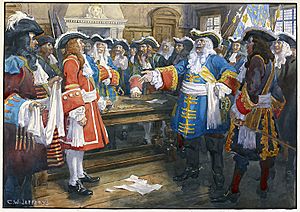
King William's War (1689–97) was part of a larger conflict between England and France that also happened in other parts of the world. New France and the Wabanaki Confederacy worked together to launch several raids against New England settlements. These were south of what is now Maine, which New France considered its border.
Sir William Phips led his New England militia in 1690 to try and take French strongholds. These included Port Royal and Quebec, which was led by Comte de Frontenac, the governor of New France. Phips conquered the capital of Acadia and other communities. (Today's Maine and New Brunswick were still disputed territories.) Phips sent a message demanding Frontenac's surrender at Quebec. Frontenac famously replied that his answer would only come "from the mouths of my cannon and muskets."
The New England militia faced Quebec's strong natural defenses, more soldiers, and the coming winter. Phips eventually sailed back to Boston with his hungry, sick, and discouraged force. His failure showed that colonists needed to learn European fighting methods and follow London's war plans to win battles.
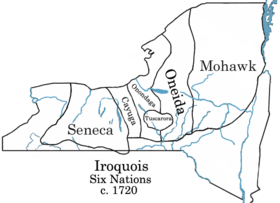 The Iroquois suffered greatly in King William's War. They became part of the French trading network, along with other western Native American groups. The way colonists treated Native American tribes after King Philip's War directly led to the Wabanaki tribe joining the war. Unlike tribes in southern New England, the Wabanaki kept significant power compared to the colonists. They rejected attempts to control them. Treaties made between 1678 and 1684 included promises of Native American independence, but these promises were often ignored. Growing settlements caused tension and led to Native American threats of violence, similar to King Philip's War. This gave the French an opportunity, and they formed new alliances. The lack of stable government after Governor Andros was imprisoned in 1689, combined with existing complaints and French encouragement, led to Wabanaki attacks on settlements along the Northeast coast. This pattern continued until the French left in 1763.
The Iroquois suffered greatly in King William's War. They became part of the French trading network, along with other western Native American groups. The way colonists treated Native American tribes after King Philip's War directly led to the Wabanaki tribe joining the war. Unlike tribes in southern New England, the Wabanaki kept significant power compared to the colonists. They rejected attempts to control them. Treaties made between 1678 and 1684 included promises of Native American independence, but these promises were often ignored. Growing settlements caused tension and led to Native American threats of violence, similar to King Philip's War. This gave the French an opportunity, and they formed new alliances. The lack of stable government after Governor Andros was imprisoned in 1689, combined with existing complaints and French encouragement, led to Wabanaki attacks on settlements along the Northeast coast. This pattern continued until the French left in 1763.
Queen Anne's War: 1702–1713
Queen Anne's War (1702–1713) was the colonial part of the War of the Spanish Succession, which was mainly fought in Europe. This conflict also involved several American Indian tribes and Spain, who were allied with France.
Carolina governor James Moore led an unsuccessful attack in 1702 on St. Augustine, the capital of Spanish Florida. He also led several raiding expeditions in 1704-6 that destroyed much of Florida's Native American population. Thomas Nairne, Carolina's Native American agent, planned to destroy the French settlement at Mobile and the Spanish settlement at Pensacola. This expedition never happened. However, the Carolinians did give firearms to their allies, the Tallapoosas, who used them to attack Pensacola. These warriors showed they could combine Native American fighting methods with European weapons. But the colonists didn't pay them enough and didn't realize how important they were for the balance of power in the Southeast. As a result, the Tallapoosas and other tribes switched sides by 1716 and used what they had learned against South Carolina settlements.
The French and Wabanaki Confederacy tried to stop New England from expanding into Acadia. New France considered the Kennebec River in southern Maine as its border. To do this, they raided targets in Massachusetts (including present-day Maine), starting with the Northeast Coast Campaign.
In 1704, French and Native American forces attacked several villages. Deerfield, Massachusetts, was ready for an attack. The attack came on the night of February 28, 1704. Much of the village was burned, many people were killed, and others were taken captive. Seventeen of the captives were killed on the way to Canada because they were injured and couldn't keep up. More lives were lost to starvation.
Major Benjamin Church fought back by raiding Acadia (see Raid on Grand Pre) and captured prisoners for ransom. The most famous Acadian captive was Noel Doiron. Eventually, 53 New England captives returned home, including Reverend John Williams, who was a target of the invaders. His stories made him famous throughout the colonies. South Carolina was especially vulnerable. Charleston repulsed an attempted raid by French and Spanish fleets in the summer of 1706.
French privateers caused serious damage to New England's fishing and shipping industries. This privateering was finally stopped in 1710 when Britain sent military support to its American colonists. This led to the British Conquest of Acadia (which became peninsular Nova Scotia), the main base used by the privateers. The war ended with a British victory in 1713. By the Treaty of Utrecht, Britain gained Acadia, the island of Newfoundland, the Hudson Bay region, and the Caribbean island of St. Kitts. France had to recognize British influence in the Great Lakes region.
After Queen Anne's War, relations worsened between Carolina and nearby Native American groups. This led to the Yamasee War of 1715. Father Rale's War a few years later changed the balance of power in the northeast.
Father Rale's War: 1722–1725
War continued in Acadia. Father Rale's War (1722–1725), also called Dummer's War, was a series of battles between New England and the Wabanaki Confederacy, who were allied with New France. After New England's Conquest of Acadia in 1710, mainland Nova Scotia was under New England's control. However, both present-day New Brunswick and almost all of present-day Maine remained disputed territory between New England and New France. New France built Catholic missions in three large Native American villages to secure their claim to the region. These were on the Kennebec River (Norridgewock), further north on the Penobscot River (Penobscot), and on the St. John River (Medoctec).
The war began on two fronts: when New England expanded through Maine and when New England established a settlement at Canso, Nova Scotia. Maine fell to the New Englanders after Father Sébastien Rale was defeated at Norridgewock. The Native Americans then retreated from the Kennebec and Penobscot rivers to St. Francis and Becancour, Quebec.
King George's War: 1744–1748
King George's War (1744–48) was the North American part of the War of the Austrian Succession. In 1745, naval and ground forces from Massachusetts captured the important French base on Cape Breton Island in the Siege of Louisbourg. During the war, the French tried four times to take back Acadia by capturing its capital, Annapolis Royal. The most famous attempt was the failed Duc d'Anville expedition. They got fortress Louisbourg back in the peace treaty.
The French led Native American allies in many raids. For example, on November 28, 1745, they destroyed the village of Saratoga, New York. More than one hundred people were killed or captured. The war merged into the War of Jenkins' Ear against Spain and ended with the Treaty of Aix-la-Chapelle (1748) in 1748.
Father Le Loutre's War: 1749–1755
Within Acadia and Nova Scotia, Father Le Loutre's War (1749–1755) started when the British founded Halifax. During this war, New France built three forts along the border of present-day New Brunswick. These forts were meant to protect against a New England attack from Nova Scotia. The war continued until the British victory at Fort Beausejour. This forced Father Le Loutre out of the region, ending his alliance with the Maliseet, Acadians, and Mi'kmaq.
French and Indian War: 1754–1763
Provincial troops, different from militias, were raised by the thirteen colonial governments. They were formed based on annual numbers requested by British commanders. These troops served in most campaigns and were used throughout North America during the Seven Years' War.
Pennsylvania Battles
The war began in 1754 when Virginia militia, led by Colonel George Washington, moved into French-controlled land near modern-day Pittsburgh. Washington was captured at Fort Necessity after surprising a French company. He was later released. He returned with 2,100 British regular soldiers and American colonists under British General Edward Braddock. This force was completely defeated at the Battle of the Monongahela in July 1755.
Acadia / Nova Scotia Battles

Even after the British Conquest of Acadia in 1710, Acadia/Nova Scotia was still mostly controlled by Catholic Acadians and Mi'kmaq. The British didn't make a strong military effort to control the region until 1749 when they founded Halifax. This started Father Le Loutre's War. The French and Indian War spread to the region with a British victory in the Battle of Fort Beauséjour (1755). Right after this battle, New England and British forces launched many military campaigns to secure their control of the region.
New York Battles
In Upper New York Province, on September 8, 1755, Commander William Johnson led the 'Battle of Lake George' (formerly known as Lac du saint Sacrement) Battle of Lake George.
British defenders at Fort William Henry (at the southern end of Lake George) were surrounded by a huge French force and their Native American allies in August 1757. The British surrendered to the French after being offered terms that included protection from the Native Americans. However, the Native American warriors' customs allowed them to take some captured enemy soldiers. They ignored French efforts to stop the violence. They killed or captured hundreds of the surrendered force. Some of them had smallpox, which caused an epidemic that killed thousands of Native Americans.
In early July 1758, British General James Abercromby led a force of over 15,000. They attacked General Louis-Joseph de Montcalm and his 3,500 French and Canadian troops at Fort Carillon. This fort overlooked Lake Champlain. The British had 44 cannons, some weighing over 5,000 pounds. The British later called the fort Ticonderoga. It controlled access to French Canada. Abercromby's attack became disorganized, and he suffered the worst British defeat of the war, with over 2,000 killed. He retreated, and the campaign failed.
Louisbourg Captured
Meanwhile, Lord Jeffery Amherst captured the major French stronghold of Louisbourg on Cape Breton Island (now part of Nova Scotia). Amherst's large British naval force of over 170 ships and 13,000 men faced strong attacks from French defenders. But British General James Wolfe found a safe landing spot out of sight of the French. The successful siege lasted seven weeks. With Louisbourg's fall, the Acadians were soon sent away from Acadia to places like France and Louisiana.
Canada Conquered
In London, Prime Minister William Pitt named Amherst as his new commander-in-chief for North America in 1759. The victory at Louisbourg opened the St. Lawrence River to the British. Amherst planned a three-part attack against French Canada. One part would go up the St. Lawrence to attack Quebec. Another would invade northward from Albany through lakes George and Champlain. The third would pressure the French in the west at Fort Niagara. The 1759 battle for Quebec City was fought on the Plains of Abraham. This battle decided the future of Canada. British forces under General James Wolfe defeated the French army of General Louis-Joseph Montcalm. Both generals were killed.
War's Impact
Historians suggest that the French and Indian War played a key role in starting the American Revolution. Some believe it helped the United States become a nation.
The events at Fort William Henry shaped American views of Native Americans. It was one of many times of violence and captive-taking. This damaged relations between Native Americans and American colonists. Even in Pennsylvania, a colony that had never had a Native American war before 1755, anger against Native Americans became very common by 1764. Most Native American groups sided with the British in the Revolutionary War, and the bad feelings only grew.
American writer James Fenimore Cooper wrote The Last of the Mohicans in 1826. This popular novel was made into several Hollywood films. Cooper described dangerous "savages" and their willingness to kill. The book created a lasting idea that Native Americans were untrustworthy and dangerous.
The victory of Wolfe over Montcalm was a key moment in shaping the identity of English-Canadians. However, Francophone Canada has not allowed celebrations of this event.
Pontiac's War: 1763
In 1760, British commander Lord Amherst suddenly stopped giving gifts of ironware, weapons, and ammunition to the Native Americans. This was a French practice that Native Americans had come to rely on. Chief Pontiac (1720–1769) was an Ottawa chief who became a leader in the Detroit area. Other chiefs in a loose group of tribes led attacks on all British forts in the Great Lakes area in the spring of 1763. Eight outposts were taken over, and British supply lines across Lake Erie were cut. Native American attacks on Fort Detroit and Fort Pitt failed. At this point, news arrived that the French had completely given up and left North America. The Native American effort quickly collapsed. Few American military units were involved, as British regular soldiers handled the fighting. The British Crown issued a proclamation in October 1763. It forbade American settlers from entering Native American territory west of the Appalachian Mountains. This was meant to reduce future conflict and plan for a Native American state in the Great Lakes region.
By forcing the French out of North America, the British victory made it impossible for the Iroquois and other Native American groups to play rival European powers against each other. The Native Americans who had been allied with France realized their weak position when Amherst stopped the gift-giving. They reacted quickly to Britain's sudden changes in trade rules and stopping diplomatic gifts. They launched attacks to drive British troops from their forts and sent raiding parties that caused panic as American refugees fled east. The Native American alliance forced the British authorities to cancel the unpopular policies and start giving gifts again. By 1764, the various tribes made peace with Britain. Native American leaders realized that their ability to organize and fight wars was not as strong as it once had been. Without a competing European power to arm and supply them, they simply could not keep fighting once they ran out of gunpowder and supplies.
The Proclamation of 1763 angered American settlers who wanted to move west. They mostly ignored it. They saw the British government as an ally of the Native Americans and a barrier to their goals. As one historian argues, "Frustrated by their government's inability to deal with the Indians, back country settlers decided that the best way to ensure safety was to rely on themselves." Such actions eventually pushed them into direct conflict with the British government. This ultimately became one of the main reasons for support for the American Revolution in the backcountry.
Images for kids
-
George Washington in 1772 as colonel of the Virginia Regiment; painting by Charles Willson Peale


